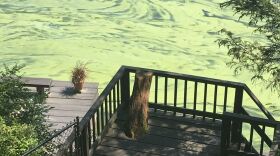For the second time in less than a week, New York Governor Andrew Cuomo was in the Hudson Valley to make announcements today. The Democrat was at the State University of New York at New Paltz to kick off the first of four summits on harmful algal blooms.
Five days after he was at Marist College to discuss his budget and announce a few economic development projects in the Hudson Valley, Governor Cuomo introduced the first of four regional summits supporting the state's effort to protect lakes and waterbodies in upstate New York from harmful algal blooms, or HABs. The Hudson Valley Summit is part of the $65 million four-point initiative unveiled in the governor's 2018 State of the State to combat HABs.
“To me, HABs are God’s way of saying, pay attention, I mean, really pay attention, and pay attention now,” Cuomo says.
The summits bring together national and state experts, including scientists and local stakeholders. Cuomo says that in two years’ time, HABs went from a sporadic to a major, consequential issue.
“These are poisons and toxins. They’re growing at a frightening rate,” Cuomo says. “2015, there were 35 cases in the state of New York, in the entire state. 2016, we found HABs in drinking water supply, which now takes it to a new level. 2017, 100 beaches close because of HABs.”
The Hudson Valley summit focuses on four of the 12 priority waterbodies that Cuomo says were chosen as the state’s most problematic. Three of the four are in Putnam County and are part of the New York City watershed. Putnam Lake in the town of Paterson has shown elevated nutrient levels typical of other New York lakes with frequent HABs. The lake has suffered more than 30 weeks of documented HAB outbreaks since 2012. Lake Carmel in the town of Kent has shown elevated algal levels, typical of other lakes in the lower Hudson with high phosphorus and nitrogen levels, and suffered 18 weeks of HAB outbreaks, resulting in more than 30 days of beach closures in 2017. And Palmer Lake in Kent and Carmel has shown elevated nutrient and algae levels, suffering its first HAB outbreak in 2017. The fourth is the Monhagen Reservoir, which serves as the drinking water supply for the city of Middletown in Orange County. Cuomo says these outbreaks and closures devastate tourism, a large part of New York’s economy.
“Worse than that, many of these lakes are sources of drinking water and once you have a polluted or dangerous source of drinking water, you have a real problem,” says Cuomo. “I am living with it now all across the state.
When Cuomo first announced the initiative in January, a few environmental groups in the Hudson Valley were disappointed that the Wallkill River was not on the list. The Wallkill flows through Orange and Ulster Counties, and is a major Hudson River tributary. It has had its share of HABs, including a severe one in 2016 that produced toxins and covered as much as 30 miles of the river with bright green algae for 60 days. So when Cuomo announced the effort to develop an action plan for 12 waterbodies, the Wallkill River Watershed Alliance and Riverkeeper called on the state to add the Wallkill to the list.
“And we think it’s a great initiative overall, but we know that the Wallkill’s problems have really been severe and that it could really benefit from this kind of look,” Shapley said.
Dan Shapley, water quality program director for Riverkeeper, speaking at the end of January. Shapley says if the Wallkill is not labeled a priority it should at least get priority attention. Cuomo says the idea is to start with 12 of the most problematic waterbodies, study them, and determine what is happening to cause the HABs and address the problem.
“Because it's not just 12 lakes in the state, and I guarantee you two years from now someone's going to be on a podium like this saying, 'This is a statewide, chronic problem,’” says Cuomo. “These twelve to me are the canary in the coal mine.”
The public portion of today’s summit on harmful algal blooms begins this hour and runs until 8. The three remaining summits are, for Central New York, March 6 in Syracuse; for the North Country, March 20 in Ticonderoga; and for Western New York, March 26 in Rochester.





